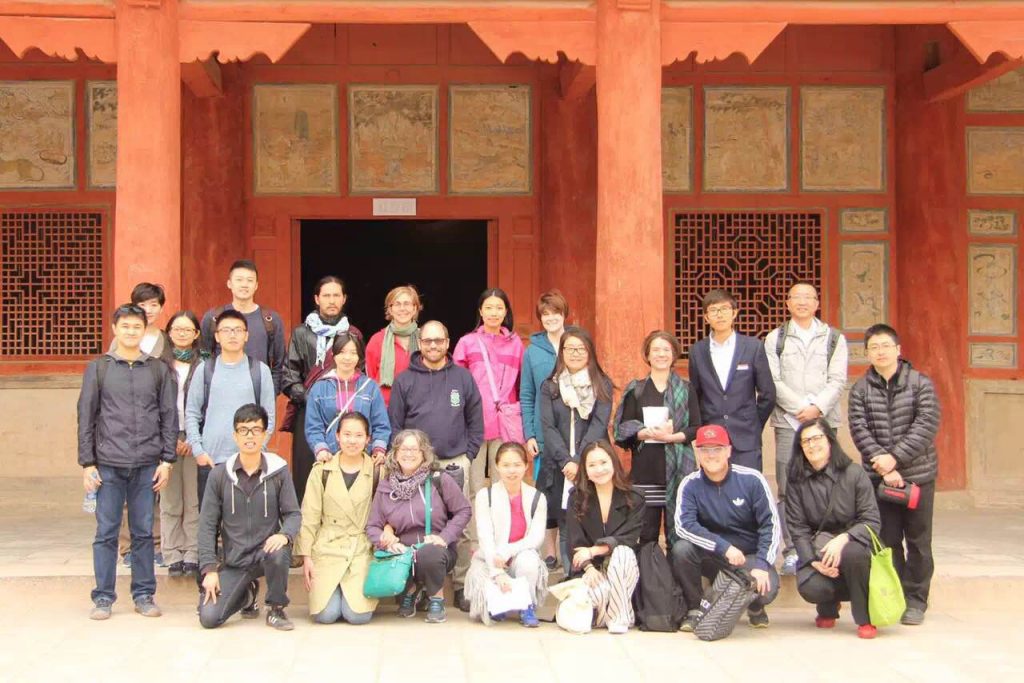The University of Toronto has launched The Robert H. N. Ho Family Foundation Centre for Buddhist Studies on its St. George campus. An endowment—originally from Tung Lin Kok Yuen, the Hong-Kong based charitable organization established by Mr. Robert H. N. Ho’s grandmother, Lady Clara Ho Tung—will provide an intellectual home for the largest contingent of Buddhist studies experts in Canada.
“Our esteemed colleagues at The Robert H. N. Ho Family Foundation have demonstrated tremendous global leadership in their support of institutions dedicated to advancing the academic study of Buddhism. I’m very proud that the University of Toronto, my alma mater, now hosts a centre that bears the foundation’s name,” commented the Honourable Dr. Vivienne Poy, Chancellor Emerita of the University of Toronto. “It will be a catalyst for innovation and new insights into Buddhism’s place in society.”
The Centre’s inaugural director is Professor Frances Garrett (PhD, University of Virginia), a professor of Tibetan and Buddhist studies and the associate chair of the Department for the Study of Religion in U of T’s Faculty of Arts & Science.
“This is an exciting time for Buddhist studies at the University of Toronto,” says Garrett. “Our scholars reflect the amazing breadth and richness of the tradition: they are delving into Buddhist ritual, art, philosophy, medicine and other intellectual developments and modes of practice in regions throughout Asia. This support creates, for the first time, a University-wide locus for advancing research, teaching and public education on an extraordinarily rich and diverse global tradition.”
The University of Toronto will join an elite global network of Buddhist studies initiatives which have received funding from The Robert H. N. Ho Family Foundation, including those at the Courtauld Institute of Art in the United Kingdom, the University of British Columbia in Canada, and Harvard and Stanford universities in the United States.
“A key objective of The Robert H.N. Ho Family Foundation is to establish a global network of outstanding scholarship in order to develop awareness and understanding of Buddhism and its relevance to contemporary society,” says Ted Lipman, the foundation’s CEO. “This goal is being realized through our collaboration with the University of Toronto. We are confident the University’s commitment to Buddhist studies and the establishment of this new centre will foster deeper insight into the meaning and context of Buddhism.”
The endowment will support academic training, collaborative research with graduate and undergraduate students, as well as a program of events that engage scholars and the public seeking to deepen understanding of the diversity of Buddhist traditions around the world. The inaugural year will feature an exciting lineup of activities, including an undergraduate research trip to the Himalayas in the spring, a film series on Buddhism and the environment, and a scholarly reading group on Dunhuang manuscripts, which are a cache of important religious documents dating from the 5th to 11th centuries discovered in the Mogao Caves in Dunhuang, China. Also being planned for August 2017 is the annual meeting of the International Association of Buddhist Studies, the largest gathering of Buddhist scholars that will be held in Canada for the first time supported by this gift.
“Having this centre located in the heart of the most religiously diverse city in the world—among which is a veritable mosaic of Buddhist communities—will position the University perfectly to facilitate intellectually informed and publicly-minded conversations on Buddhism, in terms of both its historical context and its place in contemporary society,” says Professor David Cameron, Dean of U of T’s Faculty of Arts & Science. “We are proud to be a Canadian steward of The Robert H. N. Ho Family Foundation’s legacy and vision.”
ABOUT THE UNIVERSITY OF TORONTO
Established in 1827, the University of Toronto is Canada’s largest university, recognized as a global leader in research and teaching. The university consistently ranks among the top 25 universities in the world. Its distinguished faculty, institutional record of ground-breaking scholarship and wealth of innovative academic opportunities continually attract outstanding academics and students from around the world
ABOUT THE ROBERT H. N. HO FAMILY FOUNDATION
Established in 2005, The Robert H. N. Ho Family Foundation is a private philanthropic organization based in Hong Kong. The Foundation’s dual mission is to foster appreciation of Chinese arts and culture to advance global learning and to cultivate deeper understanding of Buddhism in the context of contemporary life.
The Foundation supports efforts that make Chinese arts—from ancient times to today—approachable and relevant to audience worldwide. It encourages the creation of works, exhibitions and publications that offer original perspectives and improve the quality and accessibility of Chinese arts scholarship.
Guided by a belief that insights of Buddhism have a vital role to play in locating solutions to the challenges facing contemporary society, the Foundation seeks to expand understanding of Buddhist principles. Its current support to Buddhism includes the Buddhist Ministry Initiative at Harvard Divinity School; a centre and an endowed professorship in Buddhist studies at Stanford University; an endowed chair and program in Buddhism and Contemporary Society at the University of British Columbia; a Centre and graduate degree program for Buddhist art and conservation at The Courtauld Institute of Art; a series of Buddhist studies grants administered by the American Council of Learned Societies; the Galleries of Buddhist Art at the Victoria and Albert Museum; and presentation of art exhibitions around the world.
To learn more about The Robert H. N. Ho Family Foundation and its activities, visit www.rhfamilyfoundation.org
Media Contact
Frances Garrett
Director
The Robert H. N. Ho Family Foundation Centre for Buddhist Studies
University of Toronto
Email: frances.garrett@utoronto.ca
Diana Kuprel
Director of Alumni Relations & Advancement Communications
Faculty of Arts & Science, University of Toronto
Tel: 416-946-3118
Email: d.kuprel@utoronto.ca
Ted Lipman
CEO
The Robert H. N. Ho Family Foundation
Tel: +852 2232 0088
Email: tedlipman@rhfamilyfoundaton.org
Janet Tong
PR & Communications
The Robert H. N. Ho Family Foundation
Tel: +852 2232 0001
Email: jtong@rhfamilyfoundation.org
多倫多大學於聖橋治校區成立「何鴻毅家族基金多倫多大學佛學中心」。這所中心的資金來自香港慈善機構東蓮覺苑。東蓮覺苑是由何鴻毅先生的祖母何張蓮覺夫人所創立。何鴻毅家族基金多倫多大學佛學中心將成為加拿大最大的佛學專家雲集的學術殿堂。
「何鴻毅家族基金展示了優秀的全球領導力,支持佛學研究機構的發展。我為母校多倫多大學能夠成立何鴻毅家族基金佛學中心感到無比自豪。 」多倫多大學名譽校監利德蕙女士表示, 「此舉將推動創新思維,為思考佛教在當今社會中的地位提供新的思路。 」
該中心的首屆主任由Frances Garrett教授擔任。Garrett教授於弗吉尼亞大學取得博士學位,是藏學和佛學教授,並兼任多倫多大學藝術和科學學院副院長之職。
「對於多倫多大學的佛學研究來説這是一個振奮人心的時刻,」 Garrett教授說道。「我們的學者們潛心鑽研佛學的博大精深,他們在亞洲各地悉心探索佛教儀式、藝術、哲學、醫學和其他知識發展和實踐模式。此份捐贈在多倫多大學全校範圍內首次引發了對佛教這豐富多彩的世界傳統的研究、教學和公共教育的熱情和重視。」
多倫多大學將儕身何鴻毅家族基金資助的國際佛學研究網絡,參與此網絡的學府包括英國科陶德藝術學院、加拿大英屬哥倫比亞大學和美國哈佛大學和史丹佛大學。
「何鴻毅家族基金的主要目標就是在全球建立一個卓越的學術專家網絡,從而進一步提高對佛教及其在當今社會中的相關性的認知和了解。」基金的行政總裁黎義恩 (Ted Lipman) 說。「與多倫多大學的合作幫助我們達到這項目標。我們堅信透過多倫多大學在佛學方面的執著探索及新研究中心的成立, 能促進對佛教真諦及其意義的研習和理解。」
投入該中心的資金將用於開辦學術培訓及研究生和本科生的研究合作項目,同時還用於開展活動項目,與學者及公眾進行交流,旨在進一步深刻了解全球佛教傳統的多樣性。中心開辦的首年將舉行一系列活動,包括於春季组織本科生赴喜馬拉雅山進行學術研究,播放有關佛教及環境的電影系列,以及組織學術閱讀小組,研究在中國敦煌莫高窟中出土的敦煌文獻。同時,2017年8月的國際佛學研究學會年會也正在籌辦之中,這將是在本贊助的支持下,在加拿大籌辦的全球佛教學者雲集的最盛大聚會。
「多倫多的佛教社區體系複雜, 種類繁多,像馬賽克一樣令人目不暇接。將該中心設立在這個世界上宗教信仰最多元化的都市將幫助多倫多大學推廣有關佛教的學術研究以及與公眾的對話和交流,有助於進一步研究佛教的歷史及其在現今社會中的地位。」多倫多大學藝術和科學學院院長David Cameron教授表示, 「我們為有此機會在加拿大幫助管理和實現何鴻毅家族基金的傳統和願景感到無比自豪。」
多倫多大學簡介
多倫多大學建校於1827年,是加拿大規模最大的高等學府。 在全球被譽為研究和教學界的領軍者。 它在全球高等學府中的排名一直保持在25名以內。 它雄厚的師資力量、在學術界取得的開拓性成就以及大量的創新學術機會一直吸引著全球優秀的學者和大學生。
何鴻毅家族基金
成立於2005年的何鴻毅家族基金,為香港獨立慈善團體,一直致力推動世界對中華文化藝術的賞析,並深化當代社會對佛理之理解。
基金在香港以至世界各地從事策略性計劃,向不同文化地域之觀眾推廣傳統以及當代中華藝術,並鼓勵具原創性的藝術創作、展覽和出版,深化同時普及中華文化藝術的學術研究。
基金深信,佛理可幫助現今社會面對各種挑戰,因此透過佛學研究和佛教藝術,推動學術界和大眾了解佛理。目前,其佛學研習國際網絡支持哈佛神學院的佛教弘法管理課程、史丹佛大學佛學研究中心及系主任教席、卑詩大學「佛學與當代社會」課程及課程主任、科陶德藝術學院佛教藝術及修復中心和碩士課程,以及一系列由美國學會理事會管理的佛學研究資助項目。基金亦支持佛教藝術展覽,並於維多利亞與亞伯特博物館設立佛教藝術專館。
了解更多有關何鴻毅家族基金的工作,請瀏覽基金網站:www.rhfamilyfoundation.org
媒體聯絡
Frances Garrett教授
何鸿毅家族基金多伦多大学佛学中心主任
电子信箱: frances.garrett@utoronto.ca
Diana Kuprel
多倫多大學藝術及科學院
校友關係和發展與交流中心主任
電話: 416-946-3118
電子信箱: d.kuprel@utoronto.ca
黎義恩
行政總裁
何鴻毅家族基金
電話: +852 2232 0088
電子信箱: tedlipman@rhfamilyfoundaton.org
Janet Tong
何鴻毅家族基金
公共關係及傳訊經理
電話: +852 2232 0001
電子信箱: jtong@rhfamilyfoundation.org


